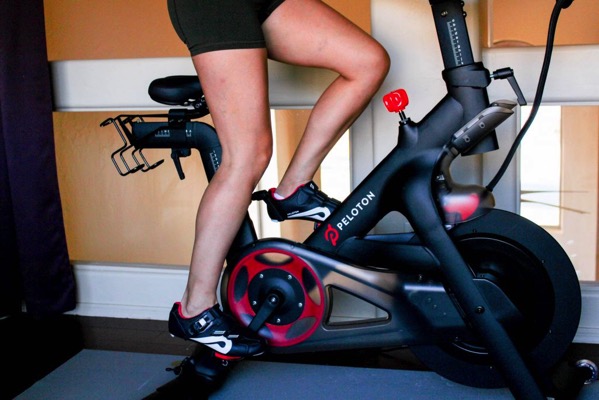Comparing HIIT and steady state cardio if weight loss is your goal.
Hi friends! How are ya? I hope you’re having a lovely morning so far! We’re still on a little trip – sharing lots of details on IG stories! – but I had some posts ready to go while I’m gone. Today, I wanted to talk about two extremely popular cardio strategies and how they compare, especially if weight loss if your goal.
For years, cardio has been a go-to solution for cardiovascular health, weight management, performance and endurance training. HIIT has also surged in popularity in the past decade and is here to stay. Sometimes there’s confusion about which type of cardio you should choose in your routine, so today, I’m breaking it all down in this post!
HIIT vs. steady state cardio for weight loss
HIIT: High-Intensity Interval Training
HIIT is like a fiery explosion of energy that revs up your metabolism and torches calories long after your workout is over. By alternating intense bursts of exercise with short recovery periods, you push your body to its limits and experience the often-touted “afterburn effect.” HIIT can increase the size and density of mitochondria, which are like the fat-burning little powerhouses in our cells.
To get the body back to homeostasis, it has to bring all pre-exercise factors back to baseline, including decreasing tissue temperature and heart rate. Your body continues to burn calories at an accelerated rate for hours post-workout.
Benefits of HIIT:
Time efficient: HIIT workouts are quick and SWEATY, which makes them ideal for busy individuals. It offers a tremendous calorie burn and fat loss potential due to its intense nature and the post-workout EPOC (oxygen consumption post exercises).
Cardiovascular benefits: HIIT also helps improve cardiovascular fitness by challenging your heart and lungs, resulting in enhanced endurance and stamina.
Performance benefits of HIIT: HIIT can also improve fitness performance, including power and strength.
Another advantage is its muscle-preserving quality, as HIIT workouts can stimulate muscle growth while targeting fat stores. Plus, HIIT can be customized to any fitness level, with modifications and variations available for beginners to advanced athletes. Incorporating HIIT into your fitness routine can rev up your metabolism, boost your mood through endorphin release, and provide a fun and challenging workout experience that keeps you motivated and engaged.
Benefits of low to moderate steady state cardio
While High-Intensity Interval Training (HIIT) gets a lot of attention, let’s not overlook the fantastic benefits of low to moderate steady state cardio. Engaging in steady state cardio, such as jogging, cycling, dancing, or swimming, brings several advantages to your fitness journey.
Cardiovascular health: it helps improve cardiovascular health by strengthening your heart and increasing your lung capacity. This type of cardio promotes endurance and stamina, making everyday activities easier and more enjoyable.
Calorie burn: Steady state cardio also aids in weight management by burning calories and facilitating fat loss.
Stress relief and mood good: It can be a great stress reliever, providing a calming and meditative experience that allows you to clear your mind and recharge.
Additionally, low to moderate cardio is often accessible to people of various fitness levels and ages, making it a suitable option for beginners or those recovering from injuries. Incorporating regular sessions of low to moderate steady state cardio into your fitness routine can contribute to a healthier heart, improved endurance, and an overall sense of well-being.
Comparing HIIT and steady state:
When it comes to weight loss, both High-Intensity Interval Training (HIIT) and steady state cardio have their unique advantages. HIIT is known for its efficiency in burning calories and promoting fat loss due to its intense nature and the metabolic boost it provides. The short, intense bursts of exercise followed by brief recovery periods create an “afterburn effect,” where your body continues to burn calories at an elevated rate even after you’ve finished your workout.
On the other hand, steady state cardio, such as jogging or cycling at a moderate intensity, is effective in burning calories during the exercise session itself. It helps create a calorie deficit, which is key for weight loss. Steady state cardio also improves cardiovascular health and endurance, making it a great option for longer duration workouts that provide mental clarity and stress relief. Both HIIT and steady state cardio can be beneficial for weight loss, so the choice ultimately depends on individual preferences, time availability, and fitness goals. Incorporating a combination of both can offer variety, prevent workout plateaus, and maximize the benefits of both training methods.
So, which one should you choose if weight loss is your goal?
The answer is… it depends.
I would take into account your fitness goals, preferences, current fitness level, hormonal health, energy level, foundations (sleep quality, stress, etc.), and lifestyle.
If you’re short on time and looking to maximize calorie burn and fat loss, HIIT can be a good bet. However, for many women, who are already stressed to the max and burned out, it can be the wrong choice. I often see HIIT over-utilized, which can contribute to stress, burnout, adrenal issues, cycle disruption, fatigue, and injury. If your stress bucket is full (either from emotional stress, toxins, medications, lack of sleep, poor nutrition, etc.), I would absolutely recommend strength training and low-intensity steady state in these situations.
Since we’re talking about weight loss in today’s post, it’s worth mentioning that you need to be a deficit for weight loss, so nutrition will play a major role. Also, if the body is in the sympathetic state (stressed, not fueled properly, not sleeping well, etc.), it will fight losing weight or fat. Relationships, toxins, sleep, stress, water quality, etc. can all play a part in achieving weight loss and health goals.
If you enjoy longer workouts and find solace in steady state cardio, go ahead and lace up those running shoes or hop on that bike. There are tremendous benefits to steady state, especially Zone 2 training, which is getting a lot of hype right now. (Let me know if you want me to do a post on Zone 2!)
Here’s a pro tip: You can also combine both approaches for optimal results. Incorporate HIIT workouts one to three times a week and sprinkle in steady state cardio sessions for variety and overall cardiovascular health. The key is to listen to your body, find what works for you, and have fun along the way.
Remember, consistency and progression are key. Whatever cardio method you choose, make sure to gradually increase the intensity, challenge yourself, and maintain a balanced approach that complements your overall fitness routine and keeps you feeling amazing!
So, friends: which do you prefer? Do you like HIIT or steady state workouts more?
If you’re looking for new workouts to do in your routine, plus meal guides, recipes, and fitness guidelines from a pro (meeee), join us for Fit Team here!
xo
Gina








